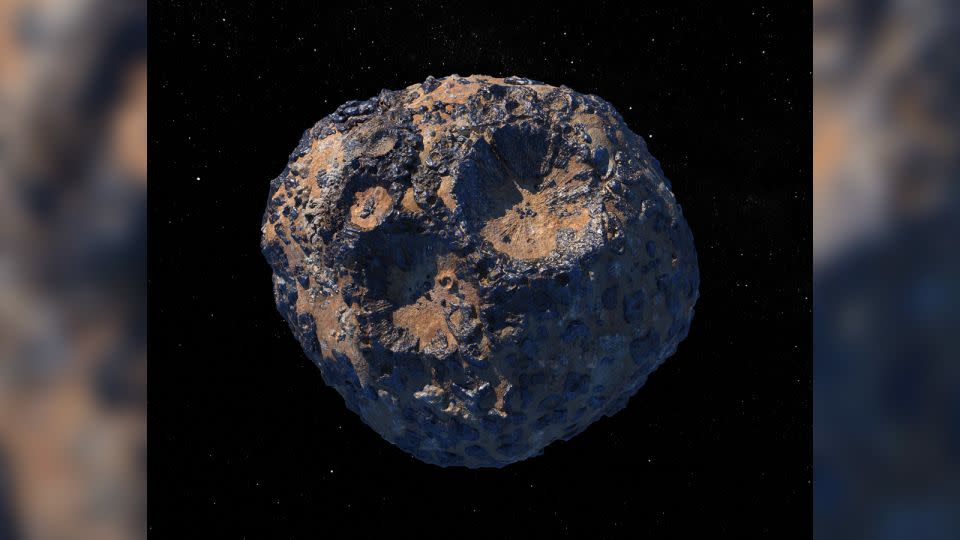Why NASA is sending a mission to a metal world
Sign up for CNN’s Wonder Theory science newsletter. Explore the universe with news on fascinating discoveries, scientific advancements and more.
For the first time, a NASA mission is setting off on a distant journey to visit a metal world in our solar system.
Getting up close with the asteroid known as Psyche is the only way to determine whether it’s the rare exposed core of an early planetary building block, according to scientists.
The metal-rich asteroid is in the main asteroid belt between the orbits of Mars and Jupiter. The namesake Psyche spacecraft is expected to lift off Thursday.
Previous missions like OSIRIS-REx have traveled to near-Earth asteroids that could potentially collide with Earth, but Psyche poses no threat to our planet. The giant space rock is about 235 million to 309 million miles (378 million to 497 million kilometers) from the sun.
After launch, the mission will arrive in orbit around the asteroid in 2029 and spend about two years studying Psyche with a suite of scientific instruments to determine its true nature.

The asteroid was discovered by Italian astronomer Annibale de Gasparis on March 17, 1852. Named for the Greek goddess of the soul, Psyche is the largest M-type, or metallic, asteroid in our system.
“Psyche is something of the poster child of the M-type asteroids,” said Dr. Zoe Landsman, science adviser to the Exolith Laboratory at the University of Central Florida, via email. “Of a group of weird and mysterious asteroids, it is the biggest, weirdest, and most mysterious.”
The lumpy, potato-shaped space rock measures 173 miles (nearly 280 kilometers) at its widest point and is 144 miles (232 kilometers) long, according to NASA.
Radar and telescope observations of Psyche have revealed that the asteroid likely contains iron and trace amounts of nickel and other metals, all of which are abundant in the solar system, Landsman said. But the asteroid’s density suggests it isn’t made of solid metal. Psyche also appears to contain some rocky material and silicate, or the material detected in glass and sand.
Researchers believe that Psyche began as the iron-rich core of a planetesimal, or an early planetary building block, perhaps similar to Earth and other terrestrial planets, from the beginning of the solar system. Over time, Psyche likely collided with other rocky objects, losing its outer crust and mantle until only its metal core remained.
“But there is a possibility that Psyche is a more primordial object that never separated into crust, mantle, and core,” Landsman said. “This is another big question that the mission can answer.”
New observations of Psyche were made in February 2022 using NASA’s now-retired Stratospheric Observatory for Infrared Astronomy, a Boeing 747SP aircraft that carried a reflecting telescope. The observations support that Psyche is an iron-rich core.

“Every time a new study of Psyche is published, it raises more questions,” said Anicia Arredondo, lead author of a new paper on Psyche and postdoctoral researcher at the Southwest Research Institute in San Antonio.
“Our findings suggest the asteroid is very complex and likely holds many other surprises. The possibility of the unexpected is one of the most exciting parts of a mission to study an unexplored body, and we look forward to gaining a more detailed understanding of Psyche’s origins.”
Arredondo presented her findings Monday in San Antonio at the joint 2023 Annual Meeting of the Division for Planetary Sciences and Europlanet Science Congress.
Scientists believe that studying Psyche could help them address key questions about planet formation. Earth, Mercury and Mars have metallic cores, but they are too deep below their planets’ rocky shells to be seen or studied directly.
If the mission’s observations confirm that Psyche is really an exposed metallic core, astronomers could learn the truth about what lies at the heart of our planet. The spacecraft’s instruments will also look for signs of differentiation on the asteroid’s surface when elements separate inside of a planet and cause heavy materials (such as metals) to sink to the middle and form a core.
“Personally, I want to know what this thing looks like!” Landsman said. “We have never seen the surface of a metal world up close. Asteroids have no atmosphere to protect them from space, and their surfaces experience weathering from micrometeorite impacts and radiation. What will space weathering look like on a metal world?”
One 2020 study hypothesized that a chunk of iron as large as Psyche may be worth quadrillions of dollars, but that kind of price tag can’t really be placed on Psyche, said Dr. Philip Metzger, planetary physicist at the University of Central Florida’s Florida Space Institute. While mining of nearby asteroids could soon be a profitable venture, Psyche is too distant to be a target, he said.
“If you brought back as much metal as likely exists in Psyche, then the metals would no longer be rare and the price would plummet,” Metzger said. “Second, the transportation cost of bringing back the metal from Psyche, which is very far away in space, is so high that you could not make any profit at all.”
For more CNN news and newsletters create an account at CNN.com

